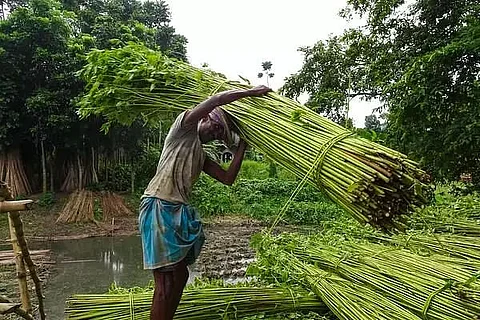
- Home
- Live Blog
- Breaking News
- Top Headlines
- Cities
- NE News
- Sentinel Media
- Sports
- Education
- Jobs

With a severe shortage of jute bags looming large in India, food grain procurement by the Central Government is poised for disruption across the country. The crisis, however, has brought opportunities for jute growers in Assam to expand the area under cultivation, increase productivity and augment the production capacities of the two jute mills in the state. For the Kharif season in 2021-22, the jute bag requirement for foodgrain procurement is equivalent to 25 lakh bales (one bale equals 180 kg), but the industry lobby- Indian Jute Mills Association (IJMA) initially committed only 18 lakh bales and further reduced it to 16 lakh bales due to shortage of raw jute for the mills. The Ministry of Consumer Affairs and Public Distribution has estimated the requirement of jute bags at 46 lakh bales for the next crop season in 2022-23 and if the present uncertainty in jute trading continues, then disruption in foodgrain procurement on account of jute bag shortage is bound to spill over to next crop season as well. The Jute Packaging Material Act, 1987 makes packing of 100% food grains and 20% of sugar products in jute bags mandatory which explains the large government demand for jute bags. The IJMA has attributed the shortage to raw jute trading drying up due to fixing of the ceiling price for jute at Rs 6,500 a quintal, in West Bengal and at Rs 6,800 in other states. The IJMA's apprehension that production capacities of jute mills may decline further if the supply of raw jute is not ensured, calls for intervention by the central government. The government fixed the ceiling price of raw jute as it fears that the high price of raw jute might lead to an increase in the prices of jute bags which in turn may push up the food grain procurement cost. The government's apprehension was justified as the price of raw jute soared to Rs 7,200 a quintal against the Minimum Support Price of Rs 4,500 a quintal. The measure, however, failed to curb hoarding as many growers are not ready to offload raw jute at Rs 6,500 hoping that it would fetch a higher price in future. This implies that for determining the cost of jute bags manufactured by the mills, the government will consider raw jute price at the ceiling fixed by the Jute Commissioner. The IJMA has expressed concern that if the mills procure raw jute at a higher price, then calculating the cost of bags at the ceiling price of raw jute will cause losses to the mills which is a genuine fear. The government taking steps to carry out intensive inspection against hoarding of raw jute can ensure trading takes place at price reasonable to all stakeholders. Double warp hemmed twill sacking bags made from jute being 100% bio-degradable, are eco-friendly and dilution of its use in foodgrain procurement with non-biodegradable bags made of plastic to make up for the shortage will prove costly for the environment and is unwarranted. The requirement of jute bags for foodgrain procurement makes the Department of Food, Consumer Affairs and Public Distribution the largest consumer of the jute industry in India which purchases jute bags of value more than Rs 7,500 crore every year. However, the over-dependence of the industry on government procurement has also come in the way of product diversification by the industry despite high global demand for diversified products such as shopping bags, handbags, fashion clothing, jewellery etc. India is the largest producer of jute in the world with three states- West Bengal, Assam, and Bihar accounting for nearly 80% of the country's total production. West Bengal accounts for the highest production and accounts for nearly 83% and the maximum number of 70 of 94 jute mills in the country are located in the state. Assam is the third-largest jute producing state after West Bengal and Bihar and very low productivity in the state drags total jute production in the state. Against high productivity of 2726 kg/hectare in Bihar and 2340 kg/hectare in West Bengal and a national average of 2051kg/hectare, the jute productivity in Assam is only 1086 kg/hectare. An increase in productivity can improve the supply of raw jute to the two mills to improve their sustainability by capitalising on the government demand for jute bags. This will, however, require augmenting the capacities of the mills including Assam Cooperative Jute Mill at Silghat through capital infusion and improvement in financial management. Increased production from enhanced productivity will also make surplus raw jute readily available for jute-based units set up by private entrepreneurs with an eye on the global markets of diversified jute products beyond the supply of jute sacks for foodgrain procurement. Assam government introducing a comprehensive jute policy will go a long way in tapping these potentials and making an investment in the jute sector highly remunerative.